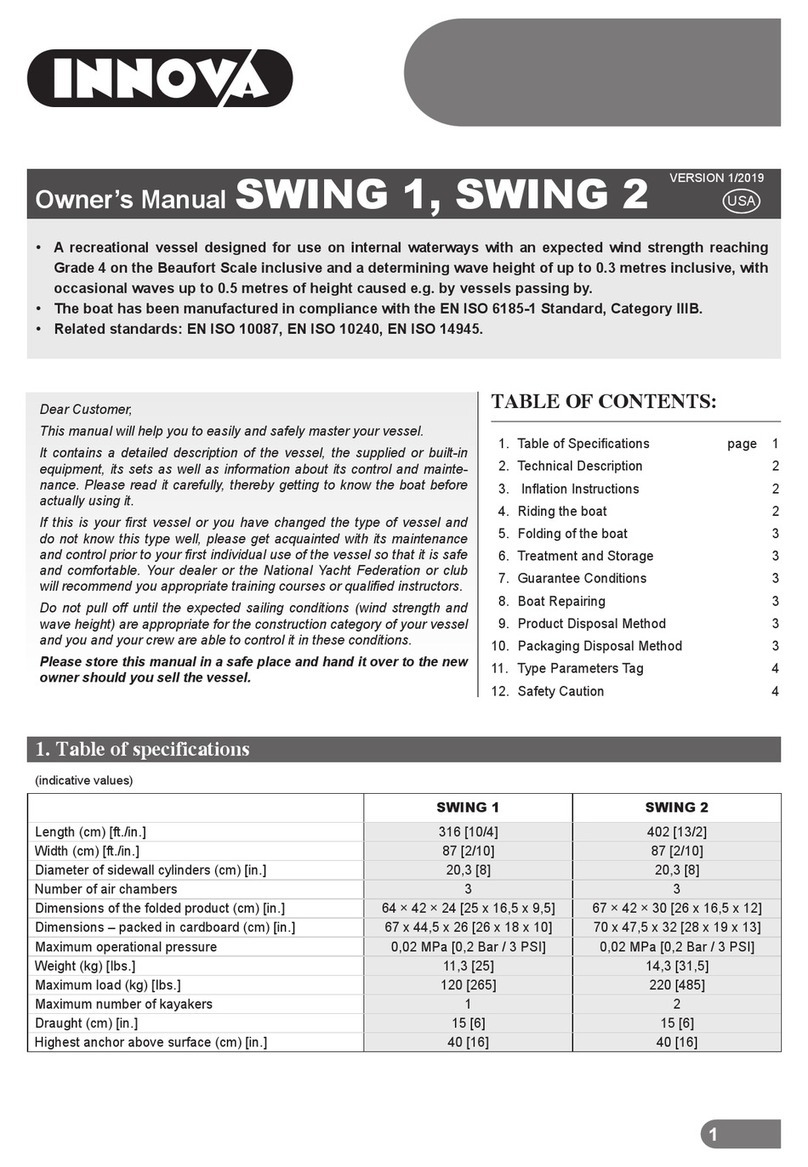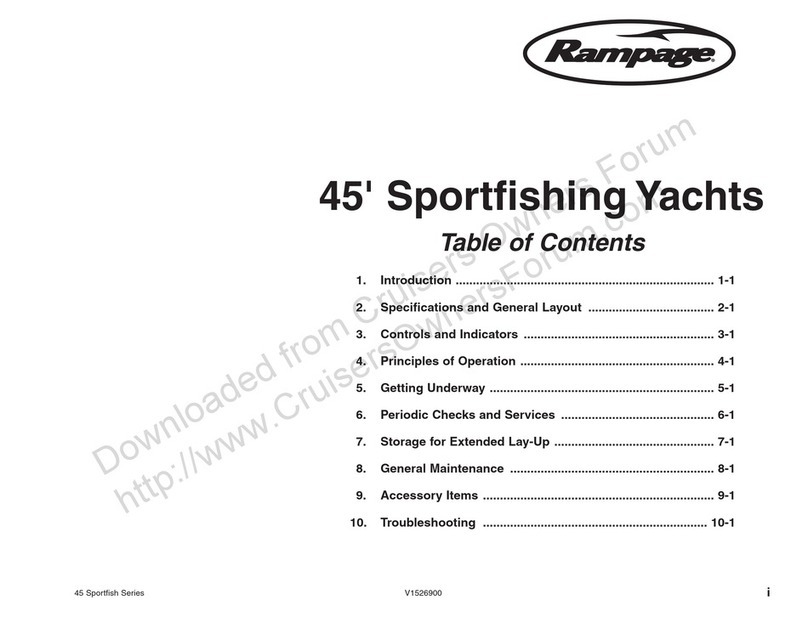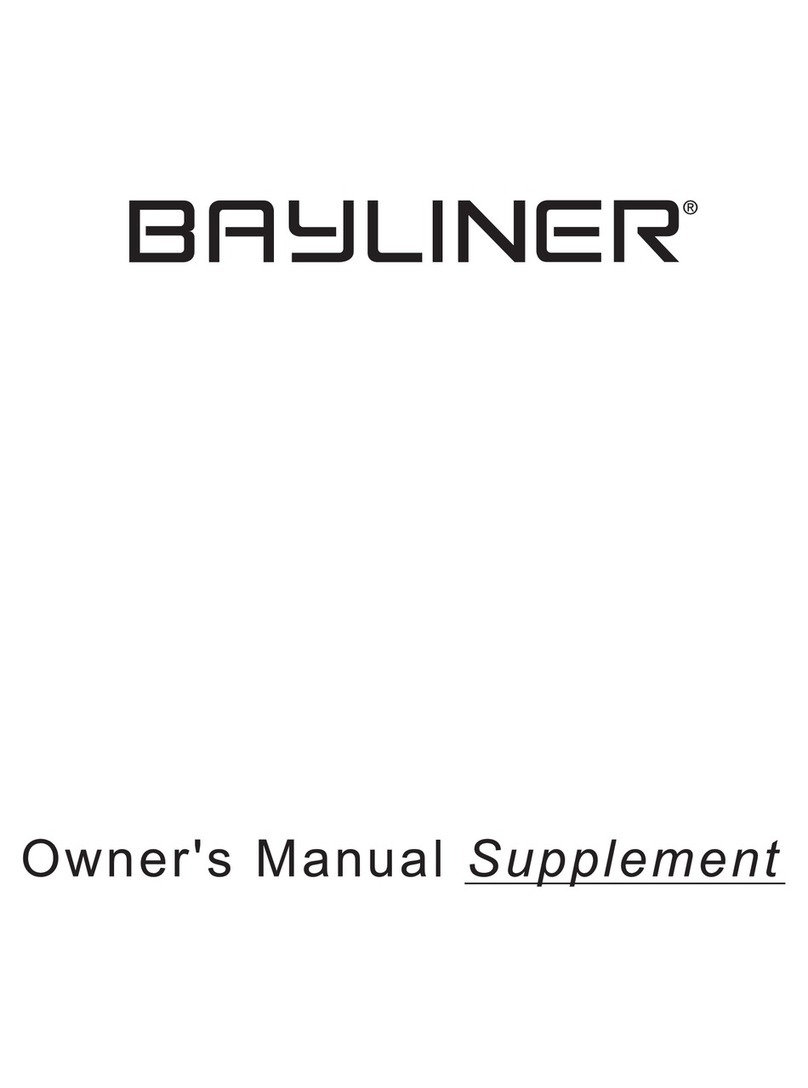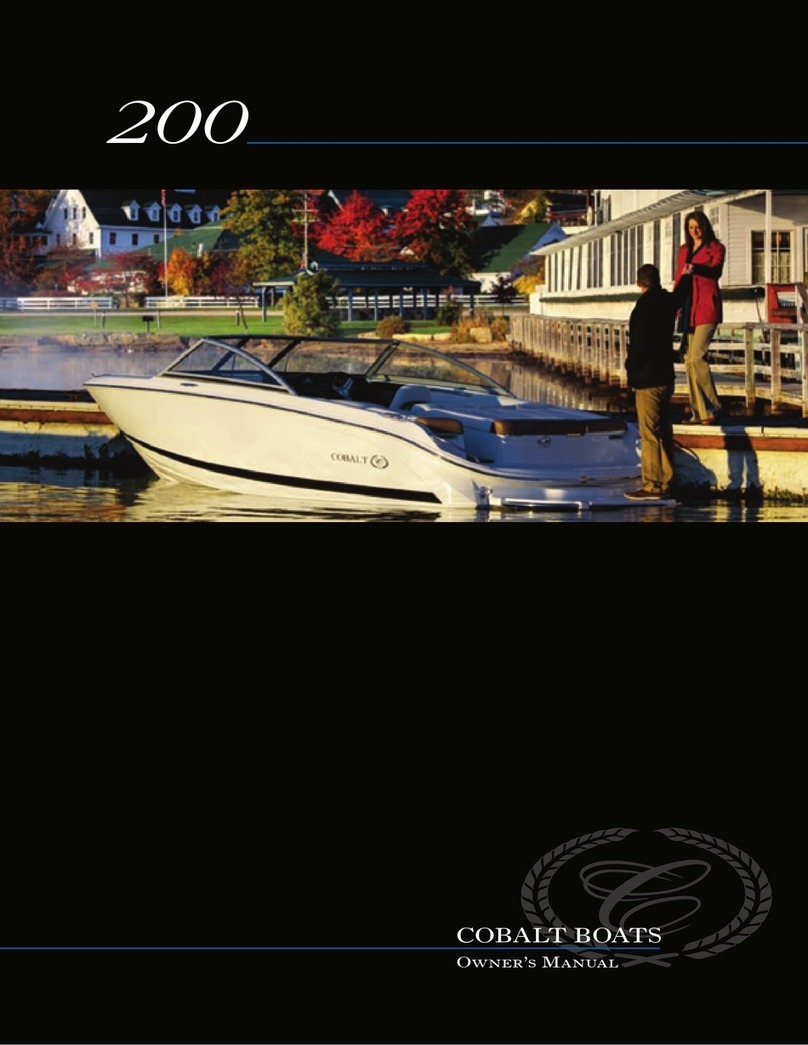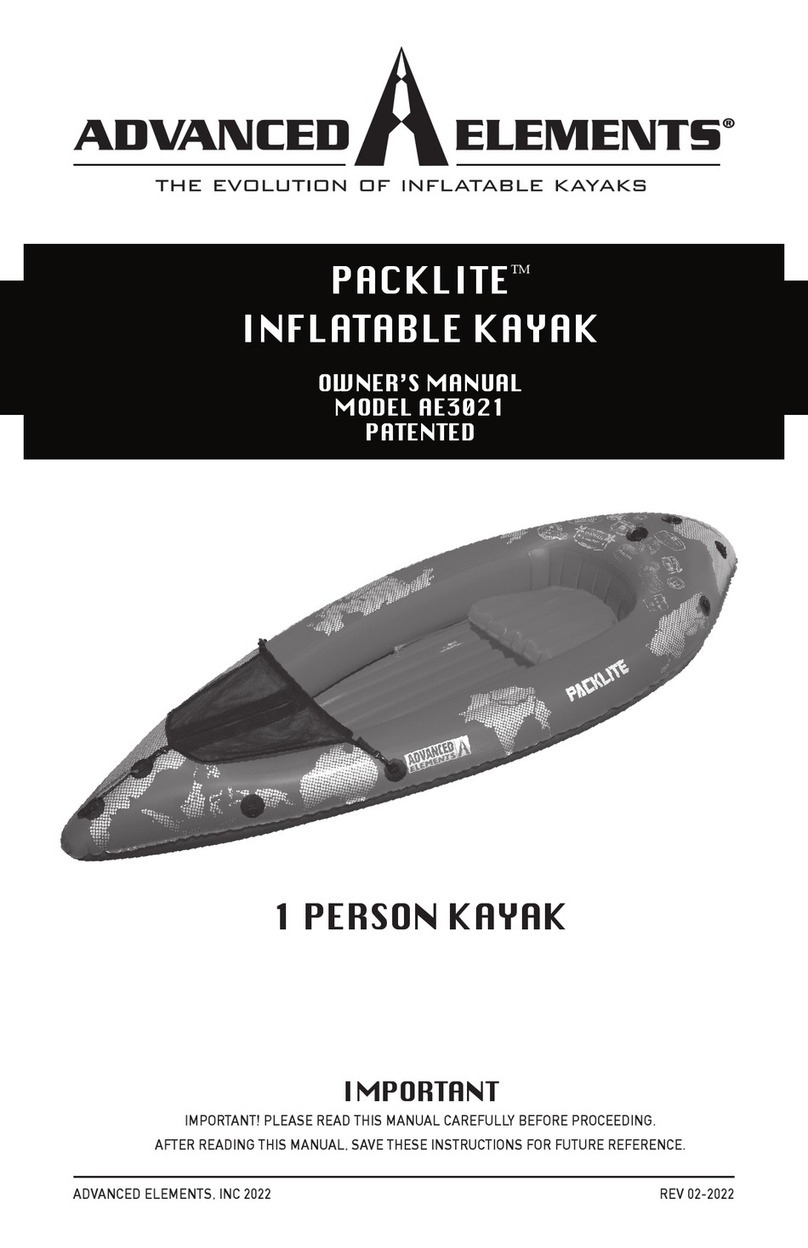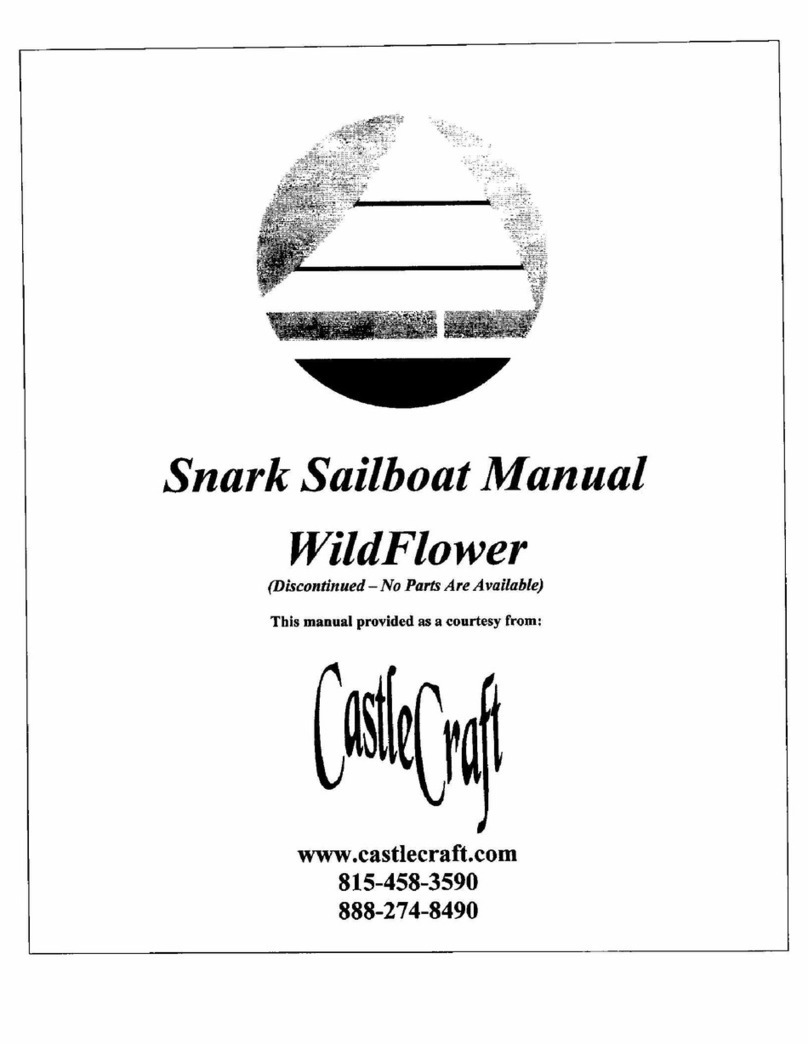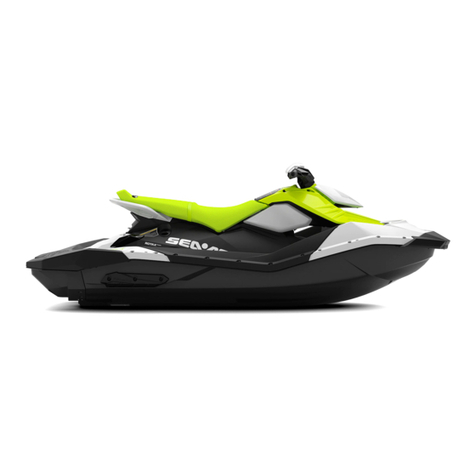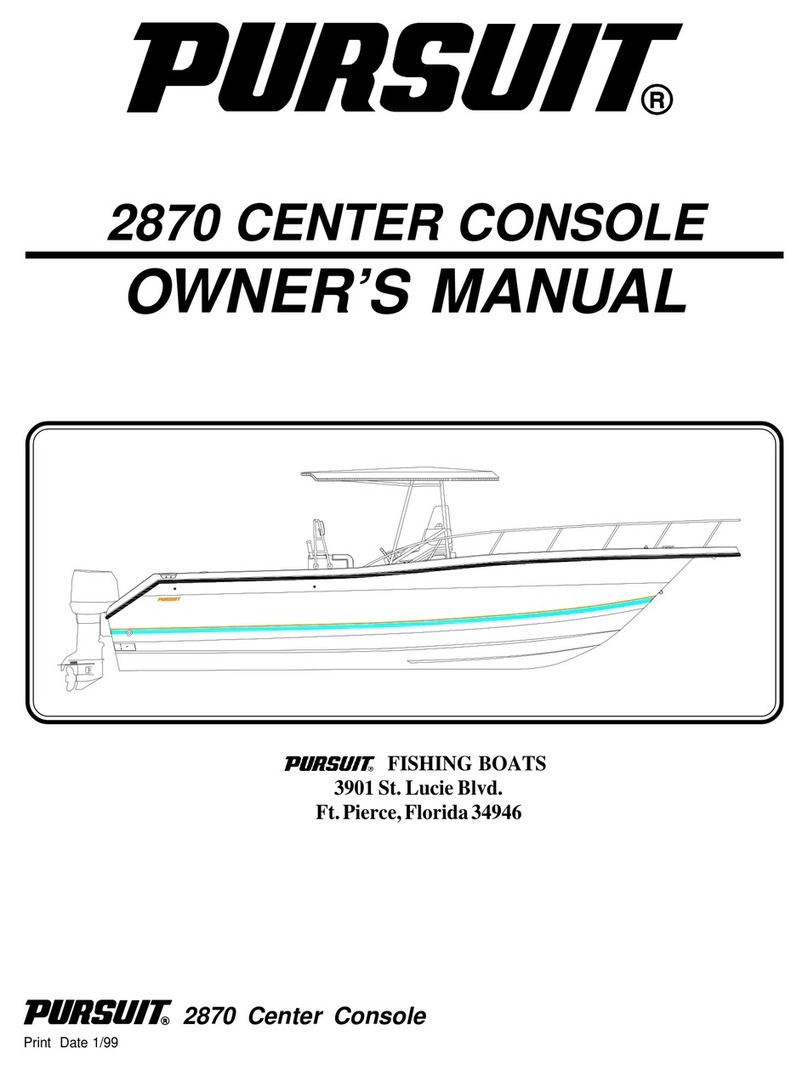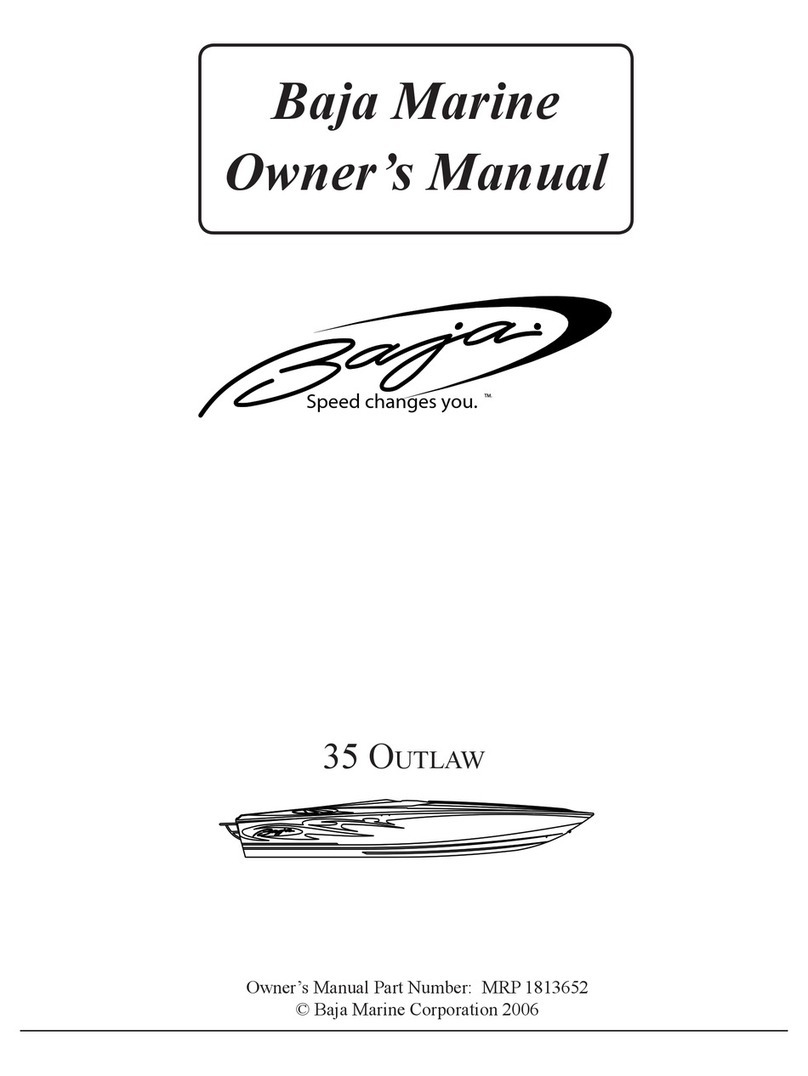Grand Soleil 43 User manual

Owner's Manual
Grand Soleil 43

© Cantiere del Pardo, 1998 – Via Selva, 10 - 47100 Forlì
Tel. 0543/782404 • Telefax 0543/782405
The copyrights of this owner's manual belong to the Cantiere del Pardo S.r.l. All rights are reserved. According to the laws
on copyrights, this manual may not be copied, either partially or wholly without the prior authorization of the Cantiere del
PardoS.r.l.Nocopiesmaybemadeforthirdparties,regardlessofwhetherthesearesoldorotherwise,buttheentirematerial
purchased may be sold, given as a gift or leased to third parties. According to the provisions of this law, the copy includes
the translation in another language or layout.
ALLYOU NEED TO KNOWABOUT THE
GRAND SOLEIL 43'
Project classification
A
SEAFARER: vessel designed to cover long range distances,
during wich the sea state can reach force 8 or more (Beaufort
Scale) with wawes height exceeding 4 m. Vessel widely self-
sufficient.
Hull Identification Number
USE AND MAINTENANCE OF EACH COMPONENT
PROGETTO GRAFICO - CANTIERI MEDITERRANEI/MAURIZIO STELLA - ANCONA

Grand Soleil 43
Owner's Manual
Introduction
The following manual has been conceived to help you using your boat safely
and pleasantly. It contains details about construction, systems, equipment on
boardandmanyothertipsandinformationaboutpracticaluseandmaintenance.
We invite you to read it carefully to achieve the necessary
familiarity before sailing your boat.
Ifthisisyourfirstboatorifyouarenotfamiliarwiththistypeofcraft,foryour
safety and pleasure make sure to have gained enough experience before you
handle the boat. Your local dealer rather than your yacht club or national
association will be glad to show you a nautical school or an expert instructor.
ALWAYS KEEP THIS MANUAL IN A DRYAND SAFE PLACE AND
HAND IT OVER TO THE NEW OWNER IN CASE YOU SELL THE
BOAT

Summary iv
Grand Soleil 43'
GRANDSOLEIL 43’
Summary
FOREWORD Introduction ................................................................................. vii
How to consult this manual, ix- Explanation of Terms, x- Reference
Symbols, x.
Notes regarding Environmental pollution, waste materi-
als, Main accident-prevention rules and Fire hazard ... xi
Environmental pollution and waste materials, xi - Main accidents-
preventionrules, xii-Safety atsea xii-Suggestions, xiv- Firehazard,xv
- Fire-fighting equipment: standar location, xvii
CHAPTER 1Technical data ............................................................................. 1.1
Specifications, 1- Certification, 1- Sail plans, 1
CHAPTER 2Anchor Windlass ........................................................................ 2.1
Instructions, 1 - Recommendations, 1 - Maintenance, 2
CHAPTER 3Auto pilot (Opt) ............................................................................ 3.1
Recommendations and Precautions, 1 - Maintenance and Instructions, 2
CHAPTER 4Battery Charger (Opt).................................................................. 4.1
Instructions, 1 - Caution, 1 - Diagram, 2
CHAPTER 5Bilge Pumps .................................................................................. 5.1
Manual Bilge Pump, 1 -Electric Bilge Pumps,1 -Recommendations, 1
- Maintenance, 2 -Bilge pumps: Location of the components, 3
CHAPTER 6Brightworks, Paint-Finish, Maintenance of Surfaces ... 6.1
Deck and Top Sides, 1 - Small Repairs to the Deck and Top Sides, 1 - Teak
Deck (Opt), 2 - Hull below Waterline, 2 - Interiors, 3 - Stainless Steel, 3
- Maintenance, 3
CHAPTER 7Electrical System ........................................................................ 7.1
12 Vdc network, 1 -Recommendations for 12 Vdc network, 1 -12 Vdc
network: the batteries, 2 -12Vdc sockets, 3 -Fuses, 3 -Magneto
thermical switches, 4 -Precautions, 4 - Opening the electric panels, 4
- Instructions, 4 -12 Vdc Control Panel, 5 - Switches group: SERVICES,
6 - PUMPS, 6 - RUNNING LIGHTS, 7 - INSTRUMENTS, 7 - 220 Vac network,
8-Cautions,8-220VacElectricalpanel,9-220Vacsockets,9-Water
tank gauge, 9 -Fuel tank gauge, 9
CHAPTER 8Engine: System and Mechanics ............................................. 8.1
Fuel System and Tank, 1 -Recommendations and precautions,2 - Mainte-
nance,2-EngineWaterCoolingSystem,2 -Maintenance,3-EnginePanel,
ControlLeverandEngineCut-Offpushbutton,3 - Instructions,4-Engine
start-up,4-Instructionsforenginestart-up,4-Running-in,5- Engineshut-
down, 5 -General Recommendations and Precautions for Using the
Engine, 6 - Gear box, 6 -S Drive rubber gasket, 6 -Exhaust, 7 -Access
to engine, 7 -Ventilation of engine compartment, 8 -Precautions, 8

Summary v
Grand Soleil 43'
CHAPTER 9Galvanic protection ................................................................... 9.1
PropellerShaft,1-Mainengine,1-WaterHeater,1-Generalrecommen-
dations, 1
CHAPTER 10 Genoa furler ................................................................................. 10.1
Instructions, 1 - Maintenance, 1 - Genoa furling system: diagram, 2
CHAPTER 11 Hardware: Deck hardware and fittings ............................. 11.1
IdentificationofDeckandFittings,1-FunctionsoftheDeckFitting,1-General
Maintenance, 1 - Deck Hardware an Fittings: diagram, 2- Running
riggings, 3- Regular maintenance, 3 - tables, 4
CHAPTER 12 Hatches and Portholes .............................................................. 12.1
Recommendations and Precautions, 1 - Maintenance, 2
CHAPTER 13 Haulage .......................................................................................... 13.1
Lifting, 1- Lifting slings position, 2
CHAPTER 14 Mast ................................................................................................. 14.1
Stays,1 -General guidelines for masttuning,1 - Tuning, 2- Recommenda-
tions for the tuning of the Babystay and the Inner Forestay, 3 - Backstay, 3
- Shrouds, 3- Tuning the shrouds, 3 - Recommendations for the tuning of
the standing rigging, 4 - Mast recommendations and periodic checks, 5
-Mast maintenance,5 - Recommendationsforthe steppingand unstep-
ping of the mast, 6- Halyard Exits on the Mast: diagram, 7
CHAPTER 15 Navigational Instruments ........................................................ 15.1
Compass, 1 -Instruments Electrical Supply, 1 -Depth Sounder Transducer
(Opt), 1 -Log Transducer (Opt), 1 -Mast Head Units and Aerials, 2
CHAPTER 16 Propane gas system .................................................................... 16.1
Stove Lighting Instructions, 1 - Cautions, 1 - Maintenance and periodical
checks, 2 -Propane smell, 2 -Changing a propane tank, 3 -Propane gas
system: diagram, 3
CHAPTER 17 Propeller ........................................................................................ 17.1
Recommendations, 1 - Maintenance, 1
CHAPTER 18 Reefs ................................................................................................ 18.1
Instructions, 1 -Taking in a reef, 2 -Letting out a reef, 2 -Warning
notices and advice, 3
CHAPTER 19 Refrigeration system ................................................................. 19.1
Frigomatic Appliance, 1 -Precautionary notices, 1 -Frigoboat Appli-
ance (Opt), 2 -Other installation components, 2 -Maintenance, 2 -
Refrigerator system: diagram, 3

Summary vi
Grand Soleil 43'
CHAPTER 20 Rudder ........................................................................................... 20.1
Bushings and Bearings, 1 - Steering Gear Elements and Cables, 1 -
Precautions , 2 - Maintenance, 2 - Access to Steering Gear Elements, 2-
Instruction for Installing the Emergency tiller, 3
CHAPTER 21 Sails ................................................................................................. 21.1
Warning notices, 1 - Maintenance, 1
CHAPTER 22 Sea Cocks and Drains - Summary Diagram ..................... 22.1
CHAPTER 23 Toilets .............................................................................................. 23.1
Instructions for the use of the marine toilets, 1 - Cautions, 1
CHAPTER 24 Tools to carry on board ............................................................ 24.1
CHAPTER 25 Waste water drainage from shower and sinks ................. 25.1
Shower waste water drainage installation, 1 - Maintenance, 2 - Sinks
drainage, 2 - Warning notices, 2
CHAPTER 26 Water Heater ............................................................................... 26.1
Instructions, 1 - Maintenance and Precautions, 2
CHAPTER 27 Water System ............................................................................... 27.1
Tanks,1 -Tankinspection,2-Fillinginstructions,2-Pressurewatersystem,
2 -Instructions, 3 -Foot pump fresh water system (Opt), 3 -Sea water
system to galley sink (Opt), 4 -Cautions and general precautions, 4 -
Maintenance, 5-Fresh water system: location of the principal compo-
nents, 6 -Water system flow chart, 6 -Fresh water manifolds diagrams,
7 -Bilge selectors diagrams, 7
CHAPTER 28 Winches .......................................................................................... 28.1
Cautions, 1 - Maintenance, 1
CHAPTER 29 Wintering ...................................................................................... 29.1
Batteries, 1 - Bilge, 1 - Bilge pumps, 1 - Canvas, 2 - Deck fittings, 2
- Electronic instruments, 2 - Engine, 2 - Fire extinguishers, 3 - Fuel
tank, 3 - Hatches, 3 - Hull bottom, 3 - Hull topsides, 4 - Interiors, 4 -
Propane gas, 4 - Running rigging, sheets and ropes, 4 - Sails, 5 -
Seacocksandhoseclamps,5 -Waterworks,5 -W.C.,5 -Tipsforasafe
winter mooring, 6
CHAPTER 30 Yacht's trim .................................................................................. 30.1

Foreword
Grand Soleil 43'
vii
FOREWORD
Introduction
The present manual has been conceived by Cantiere del
Pardo, to provide the user of the Grand Soleil 43' with useful
information on the on board systems of the yacht and to allow our
customers to utilize the 43' to its full potential in the greatest safety.
This manual, obviously, can not replace the fundamental
knowledge, experience and seamanship required to sail a yacht in
the same class as the Grand Soleil 43'. The user of such a yacht
should have acquired through direct experience or through the
hiringofaprofessionalcrewthenecessaryskilltosafelyoperatethe
vessel which can not be provided by a manual.
We strongly recommend the user to read carefully the
information provided and follow all the recommendations that the
Builderhas included in this booklet: they will allow himto take full
advantage of the yacht’s performance in the greatest safety.
The Grand Soleil 43' is the result of a great effort by the
CantieredelPardotobuildanextremelycomfortableandsafeyacht
utilizing the best materials, components and systems available,
integrating them to create a very innovative yacht.
In addition to reading all the technical data provided in this
owner’s manual we recommend a careful reading of all the
manufacturers manuals and booklets of the various components
installed on the yacht. Reference must be made to these for all
maintenance and use of the equipment.
Cantiere del Pardo reserves the right to modify the type and
position of any equipment and accessories entirely at its discretion.
Ownersmustalwaysconsultthismanualbeforeundertaking
any work which is not routine maintenance.

Foreword
Grand Soleil 43'
viii
TheGrand Soleil 43',as delivered, isstructurally sound and
in proper trim. All modifications must be carefully studied and
calculated by professionals in order to maintain the structural
integrity and stability of the yacht as designed.
The Cantiere del Pardo congratulates you on your choice!
Please do not hesitate to contact us for any explanations you may
require.
Il Cantiere del Pardo

Foreword
Grand Soleil 43'
ix
How to Consult This Manual
This manual contains the information, drawings and detailed
diagramsontheuseandmaintenanceoftheyacht,itsequipmentand
accessories.
The chapters have been listed in alphabetical order for easy
reference. Es:
Mast
The subjects in each chapter are presented as follows:
Shrouds
and analysed in the following order:
- description
- instructions on use
- recommendations and precautions
- maintenance
Wherever necessary, reference is made in the text to specific
diagrams and/or drawings.

Foreword
Grand Soleil 43'
x
Port-Starboard
Open-Closed
Explanations of Terms
The terms “Starboard” or “Port Side” always refer to the direction
from stern to bow. When specific reference is made to another
direction, the term "starboard" is replaced by “right” and "port" by
"left".
Whentheterms“open”or“closed”refertoanexhaustvalve,seacock
or valve, they indicate the position of the control lever or handle:
• when the lever is parallel to the pipes and the valve itself, the
valve is open;
• When the lever is at right angle to the pipes and the valve itself,
the valve is closed.
• indicates optional equipment or system.
Reference Symbols
Opt.
◊
Danger This symbol calls attention to an intrinsic danger which
could retail major risk of death or serious injury if the
appropriate safety measures are not followed.
Warning Thissymbolcallsattentiontoariskofinjuryorevendeath
if certain safety precautions will not be followed.
Attention Thissymbolcalls attentiontorecommended safetymeas-
ures in case of dangerous practices and uses that may
cause damage to the boat or personal injury.
Attention This symbol calls attention to possible environmental
pollution.
Maintenance calls attention to the maintenance procedure and needs
concerning the matter.
Use This symbol calls attention to the specific use and needs
of the subject.
Callsattention tothe variouspartsof thedescription ofan
item.

Foreword
Grand Soleil 43'
xi
Notes regarding Environmental pollution, waste
materials, Main accident-prevention rules and Fire
hazards
The following brief summary of the current EEC. rules about
environmental pollution, waste materials and accident-prevention
rules is valid only if the boat is used exclusively for private use and
without crew officially hired on board.
TheserulesderivefromtheInternationalConventionfortheSafety
of Human life at sea issued in London on February 1st 1974 and
following revisions and modifications.
Environmental pollution and waste materials
The environmental pollution is divided in three categories:
◊Waters
◊Air
◊Ground
• Oil free and black waters (that means those containing only
human organic wastes) may be discharged in open sea. Within
coastal waters they should be kept in specific tanks and than
discharged at open sea or through adequate systems available on
the quay or by mean of sewage draining trucks.
• The regulations concerning the air pollution that a boat can
produce are basically limited to the prohibition of using sprays
containingC.F.C.gasand tothe limitationof externalnoises that,
at a distance of 5 mt. from the boundary of the vessel, should not
exceed 65 dB(a) (decibel) from 6 a.m. to 10 p.m. and 55 dB(a)
from 10 p.m. to 6 a.m.
• Thegroundpollutionconcernsthesolidwastesunloadedonland.
In other words the EEC normative law #. 91/689 concerning the
recreational boats provides as follows:
• It is for bidden to discharge at sea any “not-biodegradable prod-
uct” either foodstuff or commercial products.
• Withincoastalwatersthenormalwastesareconsideredasurban
wastesandtherefore can be closed into hermetic plastic bagsand
than placed into trash bins.

Foreword
Grand Soleil 43'
xii
• The special wastes must be placed in special containers or, if not
available, handed to the local collectors in accordance with the
port authority regulations. Considered as such are the following
products:
- oily waters or mixtures (such as bilge water);
- black and/or white waters from W.C. or sinks;
- oils (fuels, additives and lubricants);
- chemical products labelled as “toxic” (battery acids, paints,
thinner etc. including their containers);
- spray products containing C.F.C. gas;
- batteries;
- expired distress flares;
- expired pharmaceutical products;
- products containing lead or asbestos;
- etc.
Rememberthat,accordingtotheEEClaws,untiltheaboveproducts
will not be handled to the proper collectors, you will be considered
as holder and as such you can be persecuted in case of abusive
discharge. If within the harbour area the specific trash bins are not
available, the competent authority is always the Harbour Master.
Main accident-prevention rules
Operation of any vessel is under direct responsibility of the captain!
Safety at sea
It falls upon the yacht Operator to check before departure that all
safetyequipments required bylaw arepresent on boardand ingood
working order! For updated requirements, contact your Local and
Nationalboatingauthorities.Theyachtandit’sequipmentshouldbe
kept in optimum condition: hull, machinery and safety features
should be inspected and overhauled at the proper expiry intervals
(refer to each system owner’s manual).
• Beforesailingthevessel,thecaptainandcrewmustbethoroughly
familiar with all on board systems and standard safety measures.
In addition to Standard, Local, National and International boating
laws,usesandpractices,thefollowingprecautionsmustbefollowed
while under way:

Foreword
Grand Soleil 43'
xiii
• All passengers must be made aware of the location and use of
safetyequipment(i.e.liferaft,lifejackets,fireextinguishers,fuel
remote cut off).
• All passengers must be aware of fire hazards.
• The vessel must be properly ventilated while engines or genera-
tors are in operation.
Danger !!
Carbon Monoxide Hazard
The combustion of fossil fuels produces great quantities of Carbon
Monoxide. Thisisadangerousodourlessandcolourlessgas. Proper
ventilation of the vessel is necessary while operating engines or
generators especially at low speeds, while drifting or at the dock.
• Follow proper fuel loading procedures.
• Follow the “Rules of the Road”, keep a sharp lookout and follow
all safe speed regulations.
• Do not overload the vessel, particularly either fore or aft and
distribute equally the weights to keep a proper trim.
• Requirethat allpassengers areseated and inthe cockpitwhile the
vessel is in operation.
• Always wear appropriate footware.
Warning
Operating a vessel while under the influence of any drug, including
prescription and non prescription drugs, alcohol, illegal drugs is a
felony!!
Although the majority of the following recommendation has been
widely mentioned in the individual items of this booklet, it will be
useful to remind some general rules.
• First of all it is most important to check that all the compulsory
safety equipments have a visible label proving that the item is an
approved type and still valid. These equipments include:
- all the emergency floating devices (life jackets, life rings with
floating lights, life rafts, etc.);
- distress signals (flares, EPIRB and/or Locat, VHF, SSB etc.);
- fire extinguishers (both fixed and/or movable in adequate
number, clearly indicated and of easy access).
- approved first aid kit and chemistry products still valid.

Foreword
Grand Soleil 43'
xiv
Suggestions
• Make sure that all the safety equipments (life rafts, life jackets,
etc.) are always clear are ready for use.
• Do not leave hatches and lockers wide open as they can be
dangerous pitfalls.
• Check carefully that all the handles, railings, deck walkways,
hatch tops and steps are strong, in good conditions and free from
any greasy substance that could make them slippery.
• Check periodically the good conditions of the steering gears, the
emergency tiller, the standing as well as the running rigging,
blocks, winches, etc.
• The Cantiere del Pardo delivers his boats well finished and thus
generallyfreefromdangersofaccidentalinjuries.Shouldyouadd
extrafittings,makesurenottoleaveexposedanysharporharmful
object such as screws, bolts or any sharp edge in general.
• We want to remind you that the above mentioned International
ConventionofLondonforthehumansurvivalat seaprovidesthat
at least once a year, but for sure before any transcontinental
passage all the passengers and the crew should carry out a rescue
simulation introduced by seven or more short whistles or siren
sounds followed by a long one; allthis should be duly described
and recorded in the log book.
• Finally we recommend to use yachting shoes and gloves while
manoeuvring.

Foreword
Grand Soleil 43'
xv
Fire hazard
On any vessel, fire represents a very serious hazard. All measures
should be taken to avoid and prevent all fires.
Before operating this vessel, the captain must be aware of the
following fire preventing regulations:
Thiscraftwhen inserviceshall beequipped with allthe firefighting
gears and complements provided for by law, positioned as per
builderindicationclearlymarkedwithadhesivetags(ref.todiagram
on page xvii).
It is the responsibility of the craft owner/operator to:
• PleasenotethatCO2maydamagetheenginesinteriorshoulditbe
aspirated in the engine cylinders.
• havefirefightingequipmentcheckedatintervalsindicatedonthe
extinguisher;
• replace fire fighting equipment, if expired or discharged, by
devices of identical or greater fire fighting capacity;
• inform members of the crew about the location and operation of
fire fighting equipment and the location of escape hatches;
• ensurethatfirefightingequipmentisreadilyaccessiblealsowhen
the cabins are occupied by passengers.
Danger!
•Never:
- obstruct passage ways to exits and hatches;
- obstructsafetycontrols,e.g.fuelvalves,gasvalves,switchesof
the electrical system;
- obstruct portable fire extinguishers stowed in lockers;
- leave the craft unattended when cooking and/or heating
appliances are in use;
- use gas lights inside the craft;
- modifyanyofthecraft’ssystems(especiallyelectrical,fuelandgas);
- smoke while handling fuel or gas;
- fill any fuel tank or replace gas bottles when machinery is
running or when cooking or heating appliances are in use.
• Keep the bilges clean and check for fuel and gasleaks at regular
intervals.
• Do not fit free hanging curtains or other fabrics in the vicinity of
or above cookers or other open flame devices.

Foreword
Grand Soleil 43'
xvi
• Combustible material shall not be stowed in the engine space. If
non-combustible materials are stowed in the engine space they
shall be secured from falling against the machinery and/or ob-
struct the access to it.
Danger
ThehandextinguishersuseCO2asanextinguishingmedium.Itshall
be used only to fight electric fires.
To avoid asphyxiation after discharge:
• LEAVETHEAREAIMMEDIATELY andVENTILATE BEFO-
REENTERING.
• Escape facilities other than the main companionway shall be
identified by the appropriate ISO symbol.
The Cantieri del Pardo also recommend:
1Avoid fuel spillage in the bilges, especially in the engine room.
Should a fuel leak develop:
• stop immediately the engine;
• assess leak location and if possible repair, after closing fuel
valve;
• soak up the spilled fuel before restarting the engine.
2Takeparticularcaretoavoiddirectcontactwithhighheatsources:
cooking ranges, halogen light bulbs, boiler etc.
3Asa pleasure craftoperator, you should be familiar with standard
fire fighting techniques and procedures and the use of fire extin-
guishers.
Should a fire develop follow standard fire safety procedures.
1Don't panic and keep the passengers calm.
2Stop vessel.
3Assess fire location and source.
4Avoid inhaling smoke.
5Extinguish fire following standard fire extinguishing techniques.

Foreword
Grand Soleil 43'
xvii
Fire-fighting equipment: standard location

Dati Tecnici 1.1
Grand Soleil 43'
CHAPTER 1
Technical Data
Specifications
Overall Length mt 13,20
Hull Length mt 12,90
Waterline Length mt 10,90
Maximum Beam mt 3,99
Overall clearance (standard) mt 4,04
Overall clearance (racing) mt 4,18
Draft (standard) mt 2,10
Draft (reduced) mt 1,70
Displacement Kg 8.500,00
Ballast Kg 3.100,00
Sail Area (standard mast) mq 95,05
Sail Area (extended mast) mq 98,86
Sail Area (racing mast) mq 114,41
# of berths n. 6/8
# max. of passengers n. 10
Fuel Capacity Lt. 160,00
Water Capacity Lt. 400,00
Engine (Yanmar 4JH2E) HP 40,00
Design J & J Design
Certification
Issued by R.I.NaViaCorsica,12-16128Genova(I)
Certificate #
Sail plans
Standard Extended Racing
mq. sq.ft. mq. sq.ft. mq. sq.ft.
Main sail 37,17 400,09 38,77 417,32 49,55 533,36
Furling Genoa 46,81 503,86 48,74 524,64 52,90 569,42
Light Genoa (Opt) 57,88 623,02 60,09 646,81 64,86 698,15
Olympic Jib (Opt) 37,00 398,27 38,50 414,41 41,75 449,40

Anchor Windlass 2.1
Grand Soleil 43'
CHAPTER 2
Anchor Windlass
The following instructions do not replace the information
provided in the enclosed Owner’s Manual supplied by the
Manufacturer.
◊The Grand Soleil 43' is equipped with an electric (12 Volt DC)
anchor windlass type Lofran 1000 Watt for a chain of 8mm .
◊The Anchor Windlass is located in the bow compartment. Its
motor is installed in a separate waterproof compartment accessi-
ble through the front cabin.
◊The operation of the windlass is accomplished through a control
box connected with a wire to the water proof outlet located in the
anchor locker.
◊Anadditional controlswitch (Opt) islocated in thecockpit above
the engine panel.
Instructions
• Make sure that the chain is fitted into its "wildcat" guide located
under the anchor windlass winch.
• Activate the double breaker located on the 12 Volt DC Service
Electrical Panel
• Usethecontrolboxintheanchorcompartmentortheswitchinthe
cockpit (Opt) to hoist or drop the anchor.
• When this operations has been completed, turn off the anchor
windlassswitchontheElectricalPanel,especiallyifyouleavethe
boat unattended.
Recommendations
• Whenreplacingtheanchor chainmakesurethat thechainandthe
wildcat on the windlass are perfectly matched (i.e. if you change
frommetrictostandardsize):evensmalldifferenceswillmakethe
chain “jump” and prevent it for working properly.
• Whenevertheyachtswingsarounditsanchor,thechainwilltwist.
These twists in the chain might cause the chain to “jump” on the
wildcat.Topreventthis,unwindthechainwhentheboatisdocked
and the anchor just breaks the water surface.
• In the case of system failure, check that the double magneto-
thermalsafetyswitchinthe12VdcElectricalPanelhasnottripped
automatically. If the magneto-thermal safety switch continues
tripping, locate the fault before switching it on again.
1
2
3
4
1 Chain head
2 Chain wildcat
3 Chain locker
4 Windlass push
button control socket

Anchor Windlass 2.2
Grand Soleil 43'
«Recommendations • Always use the anchor windlass with the engine running at 1/2
revs. to prevent excessive drainage of the batteries caused by the
high electric consumption of the windlass under heavy load.
- In case of emergency, the windlass may also be used with the
main engine off.
• While operating the anchor windlass, do not stand too close or
in front of the wildcat to prevent injury if the chain accidentally
jumps off the drum.
• Theanchorwindlassshouldnotbeusedasamooringcleat.Never
leave the chain in tension but secure it to the mooring cleats as
follows:
- When mooring is completed, attach a strop fastened to the
mooring cleats with one, or better, two pieces of cable to one
of the chain rings.
- Release the tension on the anchor windlass slightly, letting
chain out so that the load is on the strops and not on the
windlass.
- To secure the anchor textile line, tie it to one of the cleats.
Maintenance
As a general rule, the anchor windlass, although placed in the most
exposed area of the yacht, does not need any special care.
• Please remember that your windlass is built with component of
different metals and, subsequently, is subject to galvanic corro-
sion in the presence of salt and moisture. By hosing off the
windlass with fresh water on a regular basis to prevent salt build
up, this problem will be partially avoided.
Always refer to the enclosed Owner’s Manual supplied by the
Manufacturer.
Table of contents
